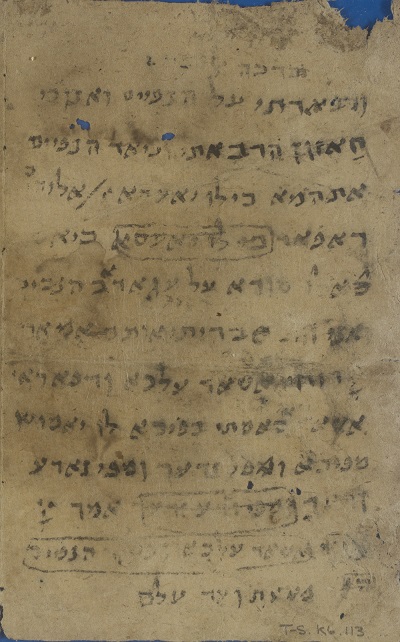The strange Hebrew of a blessing for the Prophets: T-S K6.113
Biblical verses used in medieval texts of various genres often exhibit spellings different from those of the Masoretic text. The majority of these deviations are relatively minor and involve the plene spelling of vowels that are written defectively in the biblical text. Recently, I came across a curious text consisting of three biblical verses written with drastic deviations from the standard biblical spelling. The text, preserved in T-S K6.113, fol. 2v, contains a blessing for the reading of the haftarah. It is entitled ‘the blessing for the Prophets’ and made up of Hosea 12:11, Amos 3:7, Isaiah 59:21. The text is written in a careful hand that makes the impression of being not very experienced in writing Hebrew.
T-S K6.113 folio 2 verso
Below I present the text as it is found in the fragment, juxtaposing it with the same verses in the MT. Underlined text has a box drawn around it in the original fragment, deleting it.
|
|
T-S K6.113, fol. 2v |
MT |
|
1. 2. 3. 4. 5. 6. 7. 8. 9. 10. 11. 12. 13. |
ברכת אל[נפ]יים ודבארתי על הנפיים ואנוכי חאזון הרבאתי ופיאד הנפיים אתהמא כי לו יאעסא :| אלוהים דאפאר כי לו יאעסא כיאם
ואני זות ס?ברית אותם אמאר ייָי רוחי אשאר עלכא ודפאראי אשא[ר] א?סאמתי בפיכא לו יאמושו מפיכא ומפי זרעך ומפי זארע זרעך ומפי זארע זרעך אמר ייָי רוח]י אשאר עלכא ... הנפיים] והו? מאעת ועד עלם |
וְדִבַּרְתִּי עַל־הַנְּבִיאִים וְאָנֹכִי חָזוֹן הִרְבֵּיתִי וּבְיַד הַנְּבִיאִים אֲדַמֶּה כִּי לֹא יַעֲשֶׂה אֲדֹנָי יְהוִה דָּבָר כִּי אִם־ גָּלָה סוֹדוֹ אֶל־עֲבָדָיו הַנְּבִיאִים וַאֲנִי זֹאת בְּרִיתִי אוֹתָם אָמַר יְהוָה רוּחִי אֲשֶׁר עָלֶיךָ וּדְבָרַי אֲשֶׁר־שַׂמְתִּי בְּפִיךָ לֹא־יָמוּשׁוּ מִפִּיךָ וּמִפִּי זַרְעֲךָ וּמִפִּי זֶרַע זַרְעֲךָ אָמַר יְהוָה
מֵעַתָּה וְעַד־עוֹלָם |
A number of non-standard spelling features are conspicuous in the fragment:
1. Long qamaṣ, pataḥ, seghol and ṣere are in most cases represented by the mater lectionis aleph: חאזון for חָזוֹן (l. 3), ודבארתי for וְדִבַּרְתִּי (l. 2), אשאר for אֲשֶׁר (l. 8), הרבאתי for הִרְבֵּיתִי (l. 3). Ḥolam is also occasionally represented by aleph, e.g. סודא for סוֹדוֹ (l. 6) but it is more commonly represented by waw. Short vowels are not represented by matres lectionis.
2. Quiescent aleph is not represented: לו for לֹא (l. 4), זות for זֹאת (l. 7).
3. Fricative bet is commonly represented by peh: הנפיים for הַנְּבִיאִים (l. 2), דאפאר for דָּבָר (l. 5). Fricative bet is once represented by waw: עואדאב for עֲבָדָיו (l. 6). In the same word consonantal waw is represented by bet.
4. Sin is represented by samekh: יאעסא for יַעֲשֶׂה (l. 4), סאמתי for שַׂמְתִּי (l. 9).
5. Plosive gimel is originally represented by kaph, which is crossed out and a gimel is added on top: ?כגאלו for גָּלָה (l. 6)
6. Fricative dalet is once written with tav and heh: אתהמא for אֲדַמֶּה (l. 4), possibly to indicate aspiration.
Strange as it may appear upon first glance, this spelling is not random. In fact, features 1–5 are regularly attested in Karaite and Muslim transcriptions of Biblical Hebrew into Arabic script. In the 10th and 11th centuries Karaite scholars in Palestine transcribed biblical texts into Arabic script. The purpose of these transcriptions was to preserve the reading tradition of the Bible as opposed to its consonantal text. It appears that our fragment is a re-transcription of the blessing from the Arabic into the Hebrew script. It may have been penned by someone preparing to publicly read the haftarah.
That the text is copied from a Vorlage rather than from memory is shown by scribal errors of dittography: the passages marked for deletion in lines 5 and 11–12 are repetitions of text written on the previous line caused by the writer’s eye jumping up, e.g. from the second to the first כִּי in Amos 3:7.
The Karaite connection of the text is indicated by the rest of the bi-folio, although it is copied in a different, more skilled hand than ‘the blessing for the Prophets’. T-S K6.113, fols 1v–2r contain a florilegium of biblical verses on the themes of study, the Torah and the commandments, including Isaiah 50:4, Psalms 119:18, Deuteronomy 6:25 and Psalms 147:2, etc. This florilegium is contrasted in the fragment with the Rabbanite ‘blessing for the Torah’, בָּרוּךְ אַתָּה ייי אֱלֹהֵינוּ מֶלֶךְ הָעוֹלָם אֲשֶׁר בָּחַר בָּנוּ מִכָּל הָעַמִּים וְנָתַן לָנוּ אֶת תּוֹרָתוֹ. בָּרוּךְ אַתָּה ייי נוֹתֵן הַתּוֹרָה, suggesting that the florilegium itself is Karaite.
Bibliography
Frank, D. (2003). ‘Karaite prayer and liturgy’, in M. Polliack (ed.), Karaite Judaism: a guide to its history and literary sources (Brill: Leiden, Boston), pp. 559-589.
Goldberg, P. (1957). Karaite Liturgy and its Relation to Synagogue Worship (Manchester University Press).
Khan, G. (1990). Karaite Bible Manuscripts from the Cairo Genizah (Cambridge University Press).
Khan, G. (2013). ‘Transcriptions into Arabic Script: Medieval Karaite Sources’, in G. Khan (ed.), Encyclopedia of Hebrew Language and Linguistics. Consulted online on 15 October 2018. http://dx.doi.org/10.1163/2212-4241_ehll_EHLL_COM_00000562
Outhwaite, B. (2000). A Descriptive Grammar of the Medieval Hebrew of the Cairo Geniza Letters (unpublished doctoral thesis). https://doi.org/10.17863/CAM.17175
Cite this article
(2018). The strange Hebrew of a blessing for the Prophets: T-S K6.113. [Genizah Research Unit, Fragment of the Month, October 2018]. https://doi.org/10.17863/CAM.34053
If you enjoyed this Fragment of the Month, you can find others here.
Contact us: genizah@lib.cam.ac.uk
The zoomable images are produced using Cloud Zoom, a jQueryimage zoom plugin:
Cloud Zoom, Copyright (c) 2010, R Cecco, www.professorcloud.com
Licensed under the MIT License

